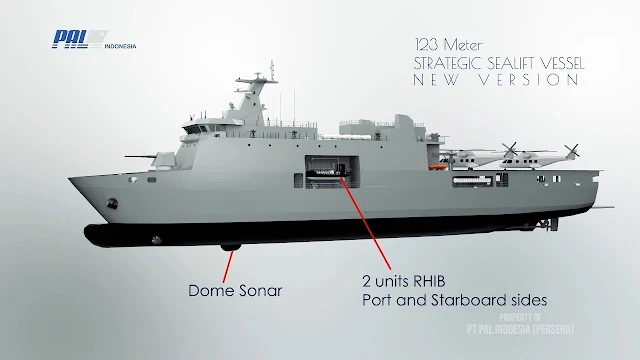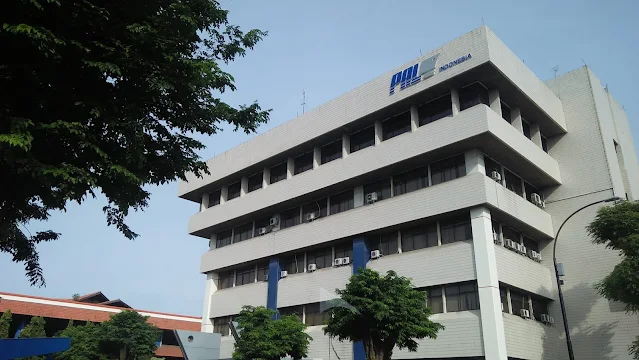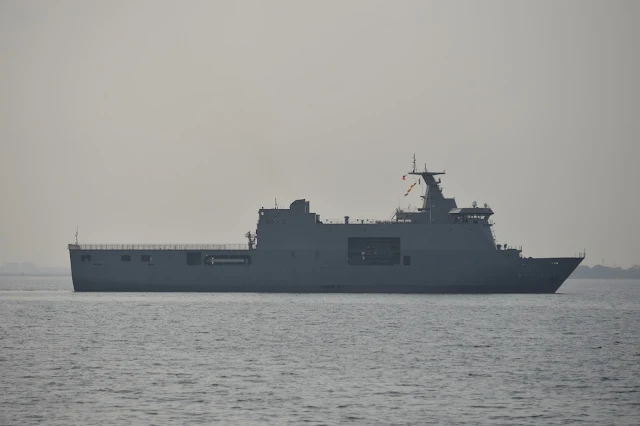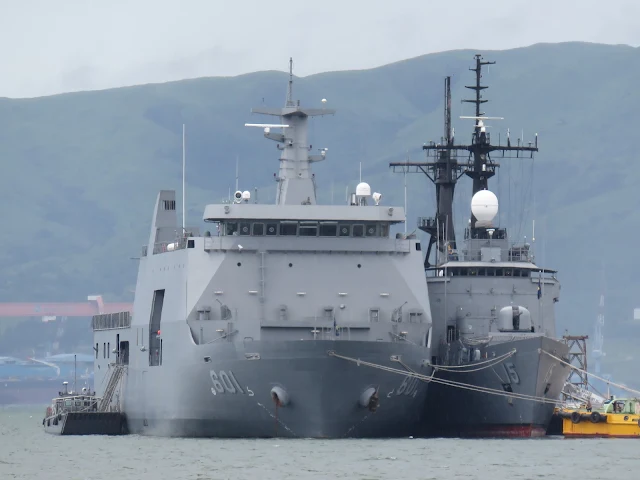Since the start of implementing the Revised AFP Modernization Program or the Republic Act 10349 way back in 2013, the Philippine Navy were in the works of improving its fleet of warships, ranging from obtaining additional Frigates, Corvettes, and even Offshore Patrol Vessels sought to replace its old World War 2 vessels, most of which already retired at the time of this article's writeup.
One of those implemented is the Strategic Sealift Vessel or the SSV program, sought to buy 2 Landing Platform Docks to the Philippine Navy, whereby they successfully provided the deal that produced such naval vessels of what is now known as the Tarlac-class Landing Platform Docks.
The Philippine Navy will have two more of such type of naval vessels, under an entirely different acquisition project known as the "Landing Docks Acquisition Project".
DISCUSSION OVERVIEW
 |
| The new design of the PT PAL's prospective Landing Platform Dock, with a sleeker design. It closely resembles the Philippine Navy's Tarlac-class Landing Platform Docks. (c) PT PAL Persero Indonesia, YouTube. |
Six years ago, in 2016, the year when the Pitz Defense Analysis website was still in its infancy, the Philippine Navy's newest Landing Platform Dock BRP Tarlac LD-601 has christened and launched as a newest vessel of the Philippine fleet in Indonesia's PT PAL drydock, wherein it took place January of that year, with the projected delivery of the Landing Platform Dock to the country will take place five months from the said event.
Just as projected, the newest Landing Platform Dock in the Philippine Navy, as well as the largest Philippine Navy-owned vessel to date, arrived in Manila's Pier 13 in May 2016, exactly a year before BRP Tarlac's sister ship, BRP Davao del Sur, arrived in the country whereby it marked the completion of the Philippine Navy's Strategic Sealift Vessel Acquisition Project, aiming to buy at least two Landing Platform Docks for the fleet.
Since then, both of the aforementioned landing platform docks that form the Tarlac-class are currently serving the Philippine Navy in their full capacity, serving in delivery of goods and personnel both in times of war and natural calamities, such as transporting military personnel from the conflict in the 2017 Marawi Siege or the delivery of relief goods to the victims affected by the devastation of Typhoon Odette in Siargao island.
Years later, up to the date this article has published, the Philippine Navy has once again provided the contract to have another two Landing Platform Docks in its fleet to the Indonesian shipbuilder, with its design being reminiscent of the Tarlac-class Landing Platform Docks, which in return derived from the South Korean Makassar-class Landing Platform Docks in the Indonesian Navy, supplied by Daewoo Shipbuilding and Marine Engineering or DSME.
With the current Landing Docks Acquisition Project awarded to the Indonesian shipbuilder PT PAL Persero, this will mark the second contract being awarded to a shipbuilder from a neighboring country in the Southeast Asia Region for the production and delivery of two Landing Platform Docks, adding it up to at least four (4) of such warships that the Philippine Navy will have, all of which made by from this company.
This comes as Indonesia already has its own capable military-industrial complex, such as building its own naval assets under license like the Martadinata-class Frigates, whereby its design has derived from the SIGMA 10514 of Damen Schelde Naval Shipbuilding from the Netherlands, or the Nagapasa-class submarines of the Indonesian Navy, wherein like the Makassar-class, has derived from a design supplied by DSME known as the improved Chang Bogo-class submarines (DSME-1400).
In this topic, we will discuss in-depth this acquisition project and a similar acquisition project that came before it, especially with the construction of both BRP Tarlac and BRP Davao del Sur and its service within the Philippine Navy included in this article, as well as the history of the Indonesian shipbuilder that produces these landing platform docks and the development that came with the design of the ships that came to be what it is today.
KNOWING PT PAL INDONESIA
 |
| PT PAL's main headquarters in Surabaya, East Java in Indonesia. By Consigliere Ivan from Bontang, Indonesia - PT PAL Jan 2018, CC0, https://commons.wikimedia.org/w/index.php?curid=75609590 |
Based on the company profile that PT PAL has provided on its website in this link provided (archived), it started in 1939 when the Dutch colonial government that has its domain over the Indonesia during those times has inaugurated a shipyard named as Marine Establishment, wherein the Indonesian shipbuilder described it as the mark that PT PAL as a shipbuilder established.
During the Second World War, it is a well-known information that Indonesia, along with other countries in Southeast Asia, was under the control and occupation of the forces from the Imperial Japanese Armed Forces, whereby during this period, they took over the Dutch-inaugurated Marine Establishment and change the shipbuilder's name from such to Kaigun SE 2124.
Upon the Independence achieved by the Indonesians when they first declare it on August 17, 1945, up to its recognition by the Dutch government four years later in 1949, they nationalized Marine Establishment as a shipbuilder into what is now PAL, abbreviated as Penataran Angkatan Laut or "Navy shipyard" as translated from Bahasa Indonesia, with its aim focused on maintaining Indonesian naval vessels.
PT PAL, in its current iteration as a Limited Liability Company or Perseroan Terbatas (PT), has put into effect on April 15, 1980, based on Government Regulation Number 4 of 1980, in which its role as Indonesia's key shipbuilder gets more significant when the Indonesian government issued the Law No. 16 of 2012 that gives improvement to the country's own military defense industry, enabling it to produce more warships and civilian vessels to its customers based on their requirements, as well as making it possible for them to export warships to countries like the Philippines.
Basically, PT PAL Indonesia Persero was once a public company owned by the government until it became a state-owned limited liability company, under the umbrella of the Indonesian state-owned companies such as the PT Len Industries that focuses on developing sophisticated technologies, PT Dirgantara Indonesia that focuses more on producing aerospace products such as the NC-212i that the Philippine Air Force has, and PT Pindad which at one point marketed their Harimau Hitam and APS-3 Panser Anoa to the Philippine Army.
The warships that PT PAL as the primary shipbuilder in Indonesia produce ranges from small fast missile boats such as the KCR-60 (abbreviated Kapal Cepat Rudal) or more known as the Sampari-class fast attack crafts within the Indonesian Navy, to large Landing Platform Docks that derived from the Makassar-class Landing Platform Docks such as the Banjarmasin-class and the Philippine Navy's very own Tarlac-class that can proudly said as PT PAL and Indonesian naval industry's first warship export.
Given that the Philippines is the first country that PT PAL exports its Landing Platform Dock product aside from being the primary supplier of warships for the Indonesian Navy, it comes with an understandable logic, especially at the logistical standpoint, that the awarding of the new Landing Docks Acquisition Project will go to this Indonesian shipbuilder, especially given that the Tarlac-class Landing Platform Docks they delivered earlier came with a good reputation as it serves the Philippine Navy.
THE ORIGINAL STRATEGIC SEALIFT VESSEL ACQUISITION PROJECT
 |
| BRP Tarlac (LD-601) moored off the coast of Sangley Point In Cavite. By Lawrence Ruiz (Epi Fabonan III) - Own work, CC BY-SA 4.0, https://commons.wikimedia.org/w/index.php?curid=77729113. |
Before the recent iteration of a Philippine Navy Landing Platform Dock has visualized and materialized, there were plans laid by the Department of National Defense that seek to gain such large vessels that will benefit the country in both security-related and disaster-related matters, whereby the logistical chain of goods travelling across the archipelago is fully attainable.
This visualization started at the ending years of the Arroyo administration way back 2009, when the Multi-Role Vessel Acquisition Project has put into plans, with the primary vessel being the South Korean-designed Makassar-class Landing Platform Dock, the same ones that the Indonesians built in their PT PAL shipyard and the one that the Tarlac-class Landing Platform Docks have derived from.
The first discussions between the Philippine Navy and PT PAL for the sale of Landing Platform Dock started way back May 16, 2011, whereby this discussion has still counted as part of the Multi-Role Vessel Acquisition Project rather than the later-revised Strategic Sealift Vessel Acquisition Project, with the Indonesian shipbuilder hoping during that time that they can supply at least three units, basing an indigenous Indonesian design.
Compared it to the outcome of the Strategic Sealift Vessel Acquisition Project, what PT PAL supplied to the Philippine Navy was not that far off, as the Indonesian shipbuilder has provided the end-user at least two Landing Platform Docks, with the design considered as indigenously made in Indonesia, although elements from the original South Korean-designed Makassar-class Landing Platform Docks has given influence on the design of what would be the Tarlac-class Landing Platform Docks as it comes almost at the similar size, configuration on the helipads and hangar, down to the well deck of the warship.
Speaking of the Strategic Sealift Vessel Acquisition Project, the Invitation to Bid for the procurement of two Strategic Sealift Vessels (or Landing Platform Docks) has released by the Department of National Defense way back June 2013, with the pre-bid conference took place just a month later, on July 2nd, whereby the Approved Budget for the Contract or ABC has amounted to Php 4 Billion, just a Billion Peso less than the original Php 5 Billion acquisition plan under the original Multirole Vessel Acquisition Project.
The contract for the two Landing Platform Docks has awarded to PT PAL Indonesia (Persero) in 2014 with the signing took place in July 2014, whereby the delivery dates for both the warships has slated by at least two and three years upon the signing of the contract, in the year 2016 and 2017 for both BRP Tarlac (LD-601) and its sistership BRP Davao del Sur (LD-602) respectively, in which PT PAL Indonesia successfully delivered these vessels, the largest ones currently serving the Philippine Navy, to date.
The acquisition marked a significant milestone for PT PAL Indonesia, as this served as the very first export of a naval warship made by an Indonesian state-owned company to another country's naval fleet to use, as this further bolster the capability of the Indonesian shipbuilding industry, as well as the Indonesian military-industrial complex in its entirety, with the added confidence of making attempts on exporting their naval products to other countries such as the United Arab Emirates.
THE CURRENT LANDING DOCKS ACQUISITION PROJECT
 |
| Stern of the new Strategic Sealift Vessel Design of PT PAL, with several specifications provided. (c) PT PAL Indonesia Persero, YouTube Channel. |
Earlier in the year 2022, the Department of National Defense reiterated its interest in gaining two more Landing Platform Docks, despite the number of delays on the Landing Dock Acquisition Project since 2019 because of the disqualification of the lowest bidder, the restart of bidding process that took place after it, and the global pandemic that happened all throughout the years 2020 and 2021.
This took the defense department and the end user, the Philippine Navy, at least three years since the year this said acquisition project has started, whereby the notice of award for two additional Landing Platform Docks has just awarded recently to PT PAL Indonesia (Persero) at the contract price of Php 5.56 Billion, or at least Php 2.78 Billion per unit of a Landing Platform Dock that is an improved design of the Tarlac-class LPDs.
The said notice of award has issued on June 5, 2022, showing that the Indonesian shipbuilder has won the contract for the Landing Dock Acquisition Project, which is understandable from the logistical and logical point of view, especially given that the Philippine Navy sees the commonality on the Tarlac-class Landing Platform Docks and the one under this project as both have originated from the said shipbuilder.
PT PAL Indonesia won over other prospective bidders that have taken part in this acquisition project, such as Samkang M&T from South Korea, POSCO International, which is still from South Korea, and GOA Shipyard Limited from India, whereby they provided their own prospective bid offers for the project, but did not take through and take the bid, especially given PT PAL's record in providing the Tarlac-class Landing Platform Docks previously to the Philippine Navy.
Just like the Tarlac-class Landing Platform Docks, the new Landing Docks will still feature a dimension of around 123-meter length, 21.8 meter beam, and a 5 meter draft, although it comes with 1 unit Landing Craft Unit per Landing Platform Dock instead of two per Landing Platform Dock which can found on the Tarlac-class, and several FFBNW items (Fitted for, but not with) that may add later on a separate procurement process.
Speaking of Fitted for, but not with items or FFBNW, the Philippine Navy provided in-detail the subsystems that they have planned on installing onboard the new Landing Platform Docks, such as the 76mm Oto Melara Super Rapid Gun 120 rpm that are also found onboard the Jose Rizal-class Frigates and soon to be the new HDC-3100 Corvettes and Offshore Patrol Vessels.
Other subcomponents that counts as FFBNW are the 30mm ASELSAN SMASH RCWS (Remote-Controlled Weapons System), either the Oerlikon Millenium Gun from Rheinmetall or the GOKDENIZ Gun 35mm CIWS (Close-in Weapons System), Leonardo NA-25X Fire Control System, and Terma C-Guard Decoy Launching System, several of which are also available onboard the Jose Rizal-class Frigates or may form a part of the HDC-3100 Corvette subcomponents.
TO SUM IT UP
 |
| The Tarlac-class Landing Platform Docks comprise the largest vessels that the Philippine Navy operates to-date. (c) David Grindley, Flickr. |
The Philippine Navy, nearing the end of the Duterte administration on June 30, 2022, has signed multiple acquisition projects related to the AFP Modernization Program, most of which are from the Philippine Navy, whereby among those projects that has awarded to their prospective bidders during this period include the Landing Dock Acquisition Project.
The notice of award provided to the Indonesian shipbuilder PT PAL Persero simply adds up the number of Landing Platform Docks that the Philippine Navy may soon have, from two vessels to four vessels, all of which have made by the said shipbuilder and the design being a derivative of what the Indonesian Navy or the Tentara Nasional Indonesia - Angkatan Laut has, the Makassar-class Landing Platform Docks.
This marks as the second successful instance for the Indonesian shipbuilder to export warships to a foreign country, whereby it is at the same time a neighboring country in Southeast Asia and also a co-member of the Association of Southeast Asia Countries or ASEAN, as the deal further cements the foreign relations of both Indonesia and the Philippines regarding defense cooperation.
In this recent export prospect made by PT PAL Indonesia (Persero), it is interesting for the shipbuilder to further bolster its military industrial capability, in which it serves as one of the reference points for the Philippines shall it pursue its own Self-Reliance Defense Posture, particularly that the Revised AFP Modernization Program under the Republic Act 10349 is now nearing the Horizon 3 phase, starting from 2023 up to the year 2028.
Along the way, PT PAL Indonesia has gained itself a nice reputation wherein, along with other shipbuilders that provide the naval vessels to the Philippine Navy, such as the South Korean shipbuilder Hyundai Heavy Industries or HHI, supplied the fleet new warships that sets definition to the efforts of different administrations from 2013 up to present in arming up and improve the Philippine Armed Forces, particularly the Navy.
Eventually, both the Indonesian shipbuilder and the Philippine Navy benefit in every way in this endeavor, as the former set sights to a wider global defense market, hoping to secure deals with other countries such as the United Arab Emirates, whereby they bagged a contract for its own Landing Platform Docks, while the latter is now about to get four Landing Platform Docks, improving logistical chains in the archipelagic nation.
To surmise this article, the development unfolded in the Philippine Navy's purchase of two additional Landing Platform Docks from the same shipbuilder may open further for future cooperations, especially with the plans like having a dedicated Hospital Ship may set fruition along the way, improving the capabilities of the Navy fleet in transporting goods and equipment in areas concerned, both in wartime and in peacetime.








.png)




No comments:
Post a Comment